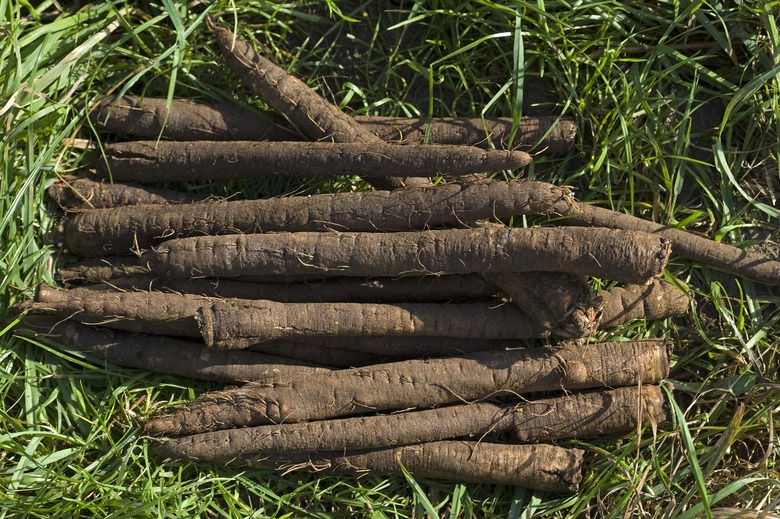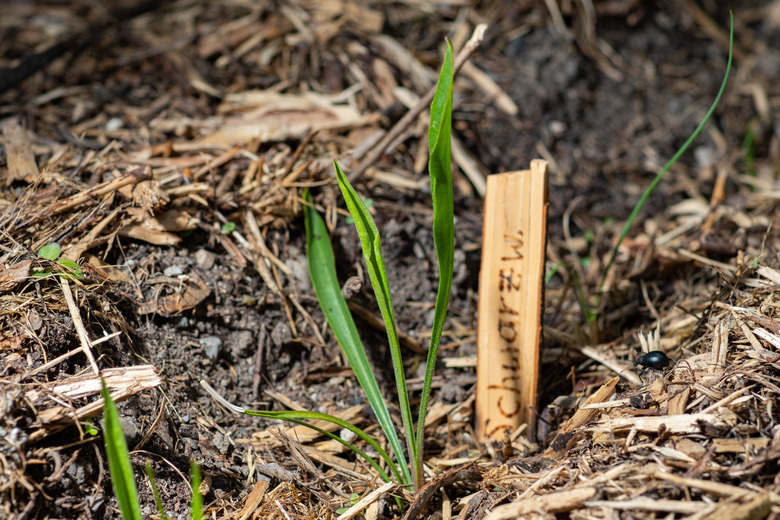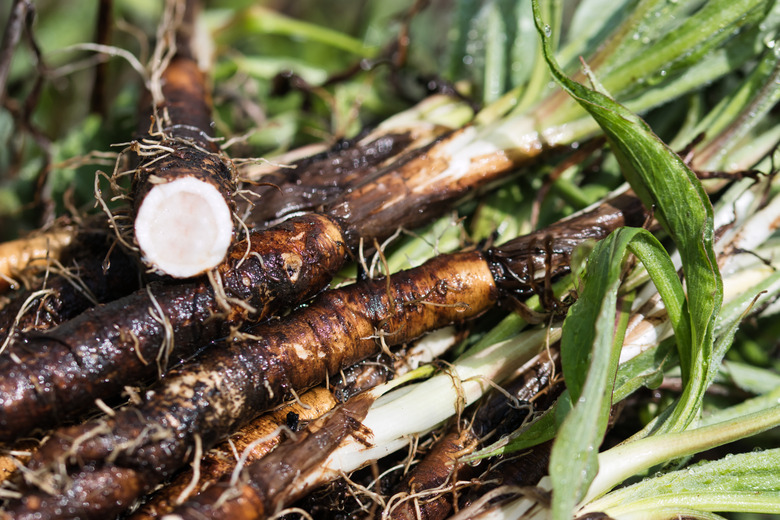How To Grow Salsify
We may receive a commission on purchases made from links.
If you like turnips and parsley, you'll probably also like salsify (Tragopogon porrifolius), and it's a bonus if you also like oysters because salsify, also known as the oyster plant or vegetable oyster, tastes like oysters (at least to some people). Others liken the taste more to that of an artichoke, and many compare the flavor to that of asparagus. These days, it's hard to find salsify at supermarkets or farmers' markets, but it used to be a common dietary item in Europe and North America. One theory about its fall from popularity says because refrigerators became available and allowed people to store vegetables that don't keep as long as salsify, they grew those vegetables preferentially.
You can boil, bake or fry salsify root, and you can also grate it into your salad, which might also contain some of the leaves. If you want to give this mysterious root vegetable a try, you'll probably have to grow your own because it is very hard to find. Be aware, however, that it's considered an invasive species in some places because of its ability to reproduce widely, so check with a local nursery or university extension before planting it.
Best Uses for Salsify
Best Uses for Salsify
Salsify is at once an edible root crop, an herb, and a potential weed. Most of the people who grow it are interested in its culinary uses, which are many, but botanists classify it as a biennial herb, and people have taken advantage of its healing properties for centuries. It is said to be good for digestion, lowering blood pressure and improving circulation, and a poultice made from the root is a traditional treatment for snake bite, which is why salsify is also known as viper's grass.
The salsify plant is about as attractive as a large dandelion, so it isn't going to be a feature in your flower garden, although you may want to use it as an accent plant in a xeriscape landscape. It is best grown in an herb or vegetable garden in full sun and protected from winds that can carry its prolific seeds far and wide. The best companion plants are other root vegetables, including carrots, turnips, parsnips, potatoes and sweet potatoes.
Root crops like salsify aren't good candidates for pots because the roots are too long, but you can grow them in raised beds. In some ways, this is preferable to growing them in the ground because they are less accessible to gophers and rabbits, and it's easier to cover them to protect them from birds, rats and extreme heat. The roots grow to a length of 12 inches, so the beds need at least that much clearance.
Starting Salsify From Seed
Starting Salsify From Seed
Salsify is always grown from seed because, like all root crops, its roots are fragile when young and don't take well to transplanting. You typically sow seeds directly in the ground in rows 18 to 24 inches apart, spacing the seeds 1 to 2 inches apart. It takes about three weeks for the seeds to germinate, and when the seedlings emerge, pinch off the weaker ones, leaving the stronger ones spaced by about 4 inches.
Sow salsify only when the ground temperature is at least 40 degrees Fahrenheit. Work the soil to a depth of 8 to 12 inches and remove rocks and stones that will prevent the root from growing downward. Once the soil is loose and free of obstructions, sow each seed 1/2 inch deep. Once the seeds are in the ground, very little care is required other than occasional watering if the weather is dry. When the seedlings emerge, application of a thin layer of mulch around the base of each plant helps control weeds.
In What Zone Does Salsify Grow Best?
In What Zone Does Salsify Grow Best?
Salsify likes cold weather, but it has a long growing season, which makes it an unsuitable crop for colder climates. It grows best in USDA zones 5 to 9, but some varieties are hardy only to zone 6. Very hot climates are also unfavorable because salsify roots turn fibrous and hard when the temperature exceeds 85 degrees. When growing in more southerly locations, it's a good idea to protect the growing plants from the sun with shade cloth on the hottest days to guarantee the best-tasting roots.
When Should You Plant Salsify?
When Should You Plant Salsify?
In areas where the ground freezes over, the best time to plant salsify is in the early spring about two weeks before the last expected frost, when the ground has thawed and the soil temperature is above 40 degrees. If you do this, you'll have a harvest in the fall. In regions without freezing temperatures, you can sow salsify seeds in the garden in the late fall and harvest the roots in late spring, thus avoiding the damaging effects of the summer sun on root production.
Soil, Sunlight, and Water Recommendations
Soil, Sunlight, and Water Recommendations
Salsify plants need nutrients, of course, but they do well in poor soil, so there's usually no need to amend it; although, it never hurts to mix in a small amount of organic matter, such as aged compost, to provide nutrients when the soil is particularly sandy. Avoid adding manure or excessive nitrogen, or the roots may fork and split. Neutral soil on the acidic side with a pH between 6.0 and 6.8 is best, and the soil should be loose and free of rocks and other obstructions.
Although it's a cool-weather crop, salsify needs full sun, and the only time shade is recommended is when temperatures exceed 85 degrees and threaten to harden the roots. Salsify can survive in relatively arid conditions, but if you want the roots to be full and juicy, keep the soil moist by watering regularly and mulching to keep weeds from growing.
How to Propagate Salsify
How to Propagate Salsify
You can propagate salsify only by seed, which can be collected from the flowers that form in both the first and second year (assuming you don't harvest the root). Like a dandelion, the salsify flower turns into a delicate puffball that separates easily in the wind. Before that happens, put a plastic bag over the puffy globe and shake the stem to dislodge the seeds or cut off the entire flower head.
Store the seeds in an airtight, watertight jar in a cool place, such as a root cellar or refrigerator. When properly stored, salsify seeds keep for one year, so you'll be able to use them for next year's crop.
How to Harvest Salsify
How to Harvest Salsify
Salsify roots are ready to harvest anywhere from 120 to 150 days after the seedlings emerge, which is in the mid to late fall if you sowed seeds in the spring. They aren't harmed by freezing temperatures and might actually get sweeter (and lose much of their oyster taste) if you leave them in the ground through a few frosts. This also lengthens the storage time, as the roots typically keep only a few months in the refrigerator or a similarly cool place after you harvest them.
The roots grow to a length of about 12 inches, and you have to be careful not to break them when lifting them out of the ground, as this greatly reduces the storage time. Instead of pulling the salsify plant out of the ground by its leaves, use a spading fork or a shovel to dig down alongside the root and lift it up from below.
Common Pests and Other Problems
Common Pests and Other Problems
Because of its thin, grass-like leaves, salsify doesn't attract many insect pests, and even aphids will leave it alone if a leafier, tastier plant is growing nearby. Perhaps more than insects, you should be on the lookout for deer and rabbits, which will definitely dine on the leaves if there's nothing better around. Spreading a deterrent such as Liquid Fence around the garden will hopefully keep them away.
Some of the more common pests that attack salsify plants include these insects:
- Carrot weevils eat the leaves, and the larvae burrow into the roots and devour them. To save the roots, it helps to dust the soil with diatomaceous earth.
- Slugs and snails love to dine on salsify leaves. Watch out for them and remove them by hand or bait them with a garden-safe commercial bait.
- Carrot rust flies lay eggs in the soil, and the larvae burrow into the roots, leaving rust-colored tunnels. Deter the flies by using row covers on the growing plants. It may also help to attract the flies away from the salsify crop by planting marigolds. (Be careful, though, because marigolds can be harmful to pets.)
- Wireworms attack the roots and can kill the plants. They are the larvae of click beetles and can be discouraged by cultivating the soil carefully down to about 8 inches before planting.
- Root nematodes cause a condition known as root knot, which is characterized by forked roots and irregular bumps. Rotate crops yearly or sow seeds that are resistant to this type of damage.
- Leafminers are small bugs that tunnel through the leaves, weakening them and inhibiting growth of the plant. Spray neem oil or a garden-safe insecticide on affected plants.
Common Diseases for Salsify
Common Diseases for Salsify
Salsify is a hardy plant that isn't susceptible to many diseases, but there are a few for which you should be on the lookout:
- White blister is a fungal infection that causes the formation of small, white blisters on the leaves and stunts plant growth. As soon as you see leaves infected with this fungus, remove them and burn them. Don't put infected leaves in the compost.
- Soft rot is a bacterial disease that affects the leaves, turning them black, white and gray and causing the root to lose its firmness. Prevent it by sanitizing your digging tools with alcohol; and when harvesting infected plants, treat them as fragile. Avoid breaking them and transfer them to a cool place immediately.


